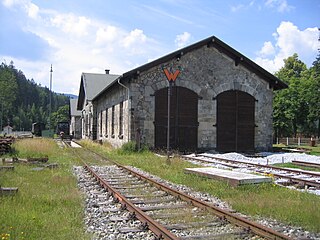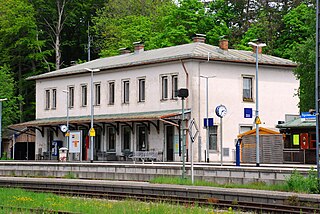
Holzkirchen is a market town in Bavaria, Germany. With a population of over 16,000 (2008) it is the largest town in the Miesbach district.

The Talent is a multiple unit railcar manufactured by Bombardier that was developed by Waggonfabrik Talbot in Aachen shortly before the company was acquired by Bombardier in 1995. The name Talent is an acronym in German for TALbot LEichter Nahverkehrs-Triebwagen.
Transdev Germany is the largest private operator of passenger buses and trains in Germany. It is a subsidiary of Transdev.

München Hauptbahnhof or Munich Central Station is the main railway station in the city of Munich, Germany. It is one of the three stations with long-distance services in Munich, the others being Munich East station and Munich-Pasing station (München-Pasing). München Hauptbahnhof sees about 450,000 passengers a day, which puts it on par with other large stations in Germany, such as Hamburg Hauptbahnhof and Frankfurt (Main) Hauptbahnhof. It is classified by Deutsche Bahn as a category 1 station, one of 21 in Germany and two in Munich, the other being München Ost. The mainline station is a terminal station with 32 platforms. The subterranean S-Bahn with 2 platforms and U-Bahn stations with 6 platforms are through stations.

The S3 is a service on the Munich S-Bahn network. It is operated by DB Regio Bayern. It runs from Mammendorf station to Holzkirchen station via Pasing, central Munich, Munich East, Giesing and Deisenhofen. Trains reverse in Munich East station and, in order for S-Bahn services from St Martinstraße to be inserted into the S-Bahn line while simultaneously reversing to run into the S-Bahn tunnel under central Munich or vice versa, the line between Munich East station and the flying junction between München-Giesing and Fasangarten stations is one of the few in Germany that has traffic running on the left.

Line S7 is a line on the Munich S-Bahn network. It is operated by DB Regio Bayern. It runs from Wolfratshausen via Höllriegelskreuth, central Munich, Höhenkirchen-Siegertsbrunn and Aying to Kreuzstraße. Trains reverse in Munich East station and, in order for S-Bahn services from St.-Martin-Straße to be inserted into the S-Bahn line while simultaneously reversing to run into the S-Bahn tunnel under central Munich or vice versa, the line between Munich East station and the flying junction between München-Giesing and Fasangarten stations is one of the few in Germany that has traffic running on the left.

Munich Donnersbergerbrücke station is a station with four platform tracks in the Schwanthalerhöhe district of the Bavarian state capital of Munich and a hub of the Munich S-Bahn. Here line S 7 separates towards Wolfratshausen from the S-Bahn trunk line. It is also served by services of the Bayerische Oberlandbahn on the Munich–Holzkirchen railway on the S-Bahn trunk line. The station is located east of the Donnersberger Bridge.

The Bavarian Localbahn Society, with its headquarters in Tegernsee, is a society that is concerned with the history of the railways in Bavaria. Localbahn means 'branch line' and is mainly used in southern Germany and Austria in lieu of the usual term Nebenbahn. The BLV's objectives are the operation of historic trains and the collection of historically valuable railway items from Bavaria.

The Mangfall Valley Railway is a single-tracked, electrified railway that runs through the Mangfall valley in Bavaria, Germany, between Holzkirchen and Rosenheim. It is exclusively used by regional services. However it also acts as a diversionary line in case of difficulties on the Munich–Rosenheim railway.

The S28 Regiobahn is a S-Bahn line in the Rhine-Ruhr S-Bahn network. It is operated by Transdev Rheinland GmbH as a subcontractor of Regiobahn Fahrbetriebsgesellschaft mbH, who is the PSO operator on behalf of Verkehrsverbund Rhein-Ruhr (VRR).

Bayerische Eisenbahngesellschaft is the passenger transport company for regional railways in Bavaria. Founded in 1995, it is organised as a GmbH wholly owned by the Bavarian Government. The company does not provide any services or own tracks or rolling stock. Instead, it purchases services from railway companies that actually operate the trains.
The Munich–Holzkirchen railway is a continuously-electrified, double-track, railway in the German state of Bavaria. It runs from Munich to Holzkirchen via Deisenhofen.

On 9 February 2016, two Meridian-branded passenger trains collided head-on at Bad Aibling, Germany. Of approximately 150 people on board the two trains, 12 people died and 85 others were injured, 24 critically.

Meridian was a commuter rail service that operated between 2013 and 2020 in Bavaria, Germany operated by the railway company Bayerische Oberlandbahn (BOB), owned by Transdev.

Holzkirchen station is a railway station on the Munich S-Bahn in the district of Holzkirchen in Upper Bavaria, Germany. It is served by the S-Bahn line S3 and Bayerische Regiobahn.

The Integral is a diesel multiple unit (DMU) train type operated by Regiobahn GmbH on commuter services in North Rhine-Westphalia. Between 1998 and 2020, they were operated by the Bayerische Oberlandbahn on regional services between Munich, Bayrischzell, Lenggries and Tegernsee. They were built by the now defunct Jenbacher Werke.

The Tegernsee station is the railroad station of the town of Tegernsee in the district of Miesbach, Upper Bavaria. It is the terminus of the railroad line coming from Schaftlach. Tegernsee station was built as part of the extension of the railroad line from Gmund station and was ceremonially opened on May 1, 1902.

The Schaftlach station is the railway station of Schaftlach and the only railway station in the municipality of Waakirchen in the district of Miesbach in Upper Bavaria. It is located on the Holzkirchen-Lenggries railway line, which opened in 1874, and has been a junction station since 1883, when the privately operated Schaftlach-Tegernsee railway went into service.




















